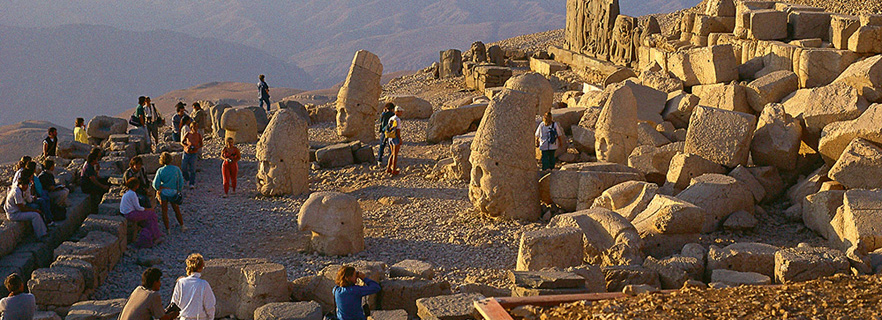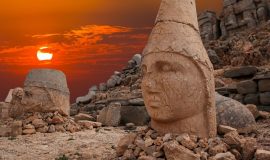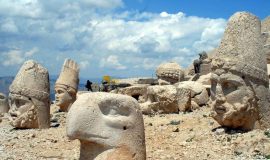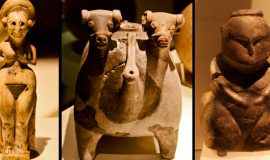 Adiyaman
Adiyaman
It lies to the west of the Euphrates River in the Southeastern Anatolia Region of Turkey. To the south of the Adiyaman central district is Ataturk Dam and Şanlıurfa, Kahta in the east, Sincik in the north, Çelikhan in the north, Tut and Besni in the west.
A project was carried out on irrigation and energy production in the soil which includes Adiyaman, Şanlıurfa, Gaziantep, Sirnak, Siirt, Batman and Mardin, and this project is GAP, Southeastern Anatolia Project. Due to the implementation of this project archaeological investigations have been carried out in the ancient settlement areas that have been under water. Due to its geographical structure, ancient civilizations shining thousands of years ago have become an intersection point and have been home to civilizations whose spirits are rarely seen throughout human history. Remains belonging to Commegene Kingdom are located on Mount Nemrut. The population of the district is 197,014 compared to 2008. The population of 10.000 in 1945 has increased to 100,045 in 1990, to 178,538 in 2000 and to 202,735 in 2010.
Etymology
Adıyaman was called "Perres" (Greek) or "Pordonnium" (Latin) during the Byzantine period. The Assyrians called Adıyaman as "Kleşdiye" in the first period. Adıyaman was captured by the Arabs under the control of the Caliph Al-Mansur in 757 AD, and was named "Hısn-ı Mansur" in the name of Mansur. After that, it will be called "Hısn-ı Mansur" as "Ottoman" or "Mansur's Castle". In the Middle Ages this name was sometimes called "Hishn-Mansur". As far as the city is called Adiyaman, if it is Islam, Armenian and Syriac will be called "Hüsn-ı Mansur" which is the name or the wrong spelling in all sources.
According to another account, in ancient times, there were seven sons of Adiyaman who believed in a pagan ruler. These seven were killed because they did not believe in the religion of the young pagan father. Therefore Adıyaman is said to have come from "Seven Yaman". These seven brothers' grave are in the south of Adiyaman.
History
Before the Republic
In the examinations made in Adıyaman Palanlı Cave, It is understood that it extends to 4000 years. Again Samsat-Sehremuz Tepe historical findings in BC. Paleolithic until 7000 BC Neolithic until 5000 BC Chalcolithic until 3000 years and BC. It is understood that Bronze Age periods lived between 3000-1200 years. During this period, the region changed hands between the Hittites and the Mitannis and the dark period began with the collapse of the Hittite state (1200 BC). B.C. BC 1200, the foundation of the Phrygian State. There was no written source about the period between 750 years. But; Since the region began to be influenced by Assyria in this period, the Assyrian effective seals in Samsat and the Hittite Hieroglyphic inscriptions in the Kahta Eskitas Village show that the historical fogs in Anatolia are continuing in the same way. In this period, the Kummuh State, one of the late Hittite city states, emerged with the collapse of the Hittite State in and around Adiyaman. B.C. With the influence of the region Assyria between the years 900-700, the Assyrians can not be fully dominant. From the beginning of the 6th century, the locality Persians dominate and the area is governed by the Satraps (governors). B.C. In 334 BC, when the Macedonian king Alexander the Great entered Anatolia, the Persians lost their dominion, Up to the 1st century BC Macedonian Seleucus Dynasty ruled. In the wake of this weakness, King Mithradetes proclaimed the independence of the 1st Kallinikos Commagene Kingdom. (69 BC) The capital city of Samosota (Samsat) is the Commagene Kingdom, ruled by M.S. The region was handed over to the Roman Empire and Adıyaman was connected to Syria (Syria) of the Roman Empire as the 6th Legion. With the separation of the Roman Empire in 395 as West and East Rome, Adıyaman joined the Eastern Roman Empire. Starting from 643, Islamic domination of the region began with the Umayyads only in 670. In 758, Mansur Ibni Cavene from the 2nd Abbasi commander became dominant. Until the year 926, Abbasi was dominated by the rulers of the Kurds, who are the Kurdish state, in the II. In 958 the region was once again in the hands of the Byzantines.
Between the years of 1114-1181, locals became Turkish raids. Between 1204-1298, Samsat and its region were taken over by the Anatolian Seljuks. Mongol attacks are experienced in 1230 and 1250. In 1298, the region and the province go to the hands of the Mamluks. Adıyaman and the airship were first taken from the local beads in the period of Yıldırım Beyazıd and entered into Ottoman domination.1402 Some local beylers which resulted in the social and political turbulences that broke down in the following years were plundered by the commanders of Timur before the Battle of Ankara were left in the hands of the Mamluks and later Dulkadiroğluları. Mainly Adıyaman 's domination of the Ottomans was followed by the Dulkadir campaign which took place during the reign of Yavuz Sultan Selim. However, the comprehensive administrative organization of the region could only be realized after the rebellions of the Kanuni period. Malatya Sancak, in the regulations made; Besni, Kahta, Hısn-ı Mansur (Adiyaman) is connected to Marash province. In 1560 Adıyaman-Samsat and the surrounding livas separated from Dulkadir Beylerbeylik and connected to Diyarbakır Beylerbeylik, but in 1574 they were again connected to Dulkadir Beylerbeylik.
Republican Period
Adiyaman, who had been in an accident due to Malatya after the foundation of the Republic from 1954 to the year of 1954, was separated from Malatya on 1 December 1954 by Law No. 6418 and became an independent province.
Transportation
Adıyaman'a by road from Sanliurfa, Malatya, Kahramanmaraş and Diyarbakir are five routes to go. Adıyaman's Gölbaşı, Malatya Kahramanmaras - Gaziantep highway transportation is provided via Gölbaşı. Railway transportation is also carried out from Gölbaşı district and Malatya-Fevzi Paşa railway passes through this district. There are plane services from Adiyaman Airport. The road connecting Adıyaman, Sanliurfa, Diyarbakir and the Southeastern provinces is connected to Şanlıurfa and Siverek by ferry services in Güzelsu village connected to Gerger County.
Industry
In Adıyaman, the industry started with Sümerbank (Pamuklu Sanayi İşletmesi), which entered the activity in 1967 and became a state organization. Later, with the Milk and Cement factories which were again the State Institution, the industry showed development. There will be no significant progress in industrialization until 1988. However, after this date, it has been observed that the industrialization efforts in our country's economy and the investments that are promoted by the industry accelerated. Particularly as a result of regional needs, the number of flour and textile factories based on agriculture has increased rapidly.
Most of the medium and small sized enterprises of Adiyaman are composed of 90 enterprises. The majority of these enterprises operate in agriculture-based industries. The total number of workers employed in these enterprises is 5053 persons. In other words, the average number of workers working in an enterprise is 56 people.
Textile industry
Within the industrial structure of Adıyaman, textile sector has an important place. Of the total 90 operators in existence, 41% are active in the textile sector. Its share in employment is 80.4%. In other words, approximately 79 people are employed in this sector every 100 people employed. Statistical information about the intra-sectoral distributions of firms in the textile sector are as follows.
Food industry
The second most important sector in Adıyaman industry is the food sector. In the food sector, flour factories have an important place. The wheat produced in the region is processed in these plants and sold to the environment illere and illiterates in the east (Bingöl, Muş etc). The total number of enterprises operating in the food sector is 31 and the ratio to the industrial enterprises is about 34%. Its share in employment is around 9%.
Oil and mining
Nearly 10% of the crude oil produced in our country is obtained from the wells of Adıyaman. However, as the opening of new oil wells slowed down in recent years, there was a decrease in production parallel to this.
Oil production is not only carried out by TPAO but also by private sector enterprises operating in the region. The production values given in the table below are only the production of TPAO. Private sector production is about 1,000,000 barrels / year.
Adıyaman TPAO produces 400 m3 of gas per day. Produced gas is used in Adıyaman stations and regional facilities. Produced crude oil is evaluated by selling to TÜPRAŞ with Botaş channel.
Energy
When energy consumption is directly related to the industry, the energy status in our province is 648.901.362 kWh of electricity received last year and 513.295.305 KWh of electricity energy sold. 60% of the electricity consumed is in industrial use, 16% is used in residential areas, and the remaining 24% is used in other areas. The electrical energy used in the industry is important compared to other customer groups. Adıyaman Cement factory, TPAO drilling facilities, Textile factories are the first orders in industrial consumption.
Since it is one of the priority illusions in scientific development, 10% to 12% discount electricity sales are made in all the subscriber groups. In addition, for all industrial establishments benefiting from the incentive loan or SME loans, a reduction of 50% for the first year, 40% for the second year and 25% for the third year has been implemented from 1999 onwards.
Because it is very close to Ilimiz Atatürk Dam and Karakaya Dam HEPPs, electricity can be taken in a healthy way and voltage drop, Such negativities do not occur in our city.
The infrastructure works for city networks, distribution lines and other electrical installations have been completely completed and renewed, all MV voltage is 33 kV.
There is no significant problem in our province and districts due to electricity energy.
For the year 2000, 648.901.362 KWh of electricity was purchased and 513.295.305 KWh was sold.
The favorite province of recent years is now a major metropolis.
Seafood
Ilimiz Dam Reservoirs, Natural Lakes, Streams and Spring Waters have a very large water potential. Many of these waters are available for Aquaculture. Trout farming is carried out in Floating Network Cages within the boundaries of our city. The total production of aquatic products in the year 2000 is 543.480 kg.
Tourism
Adiyaman is a true culture and tourism city, which has been in the center of the Southeast Anatolian Region and has a lot of different cultural centers, dating back to the early humans. Findings about the experience of all periods of human history on Adıyaman lands, one of the oldest settlements in the world, have been obtained.
Adıyaman Ili, who changed hands among various states throughout history, Hittites in 3000-1200, Assyrians in 1200-700, Phrygians in 750-600, Persians in the years 600-334, Macedonians in the years 334-69, 69-M.S. The Roman Empire between 72 and 395, the Emperor of Byzantium (East Roman) between the years of 670-758, the Abbasids of 758-926, the Byzantines of 926-958, the Byzantines again between 958-1114, 1117 -1204 Ayyubiler, 1204-1298 Anatolian Seljuks, 1298-1516 After changing hands between the Mamluks, the Ottomans entered into the rule of the Ottoman Empire in 1516.
Adiyaman is one of the most important tourism centers of the Republic of Turkey today and welcomes its guests from all over the world with its values from countless civilizations hosted throughout history.


 Adiyaman
Adiyaman














